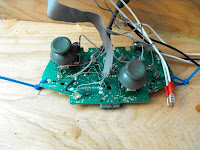If you're not going to use the pad hack method and will instead use an I-PAC or similar control chip, you can skip this part, obviously. For this stage of the construction, I recommend you have an exacto knife, some thinnish wire (~22 AWG; I actually used an IDE hard drive ribbon), a soldering kit (soldering iron and lots of solder, helping hands with a magnifier, a good lamp) and a hot glue gun.

First off, you'll need to remove the outer shell of your controller, usually using a small phillips-head screwdriver.

Once you're down to the bare PCB (printed circuit board), you'll see that all of the button contacts are covered in this weird black coating that solder won't stick to, so we gotta scrape that shit off to get to the sweet, sweet copper underneath it (you'll want to scrape off more than is shown in this picture; it's just an example).

I've heard of people using a dremel with a wire brush attachment to do this, but that sounds like a bad idea to me so I stuck with using an exacto with a square-ish blade (lay it almost flat against the board so you shave off the black stuff instead of scratching it off with the point/edge).

However you decide to do it, just make sure you don't damage the copper underneath because that's what we want to solder to.
Once you get a pair of wires soldered to their corresponding pads, I recommend you plug your controller into your PC/console and bridge the wires (i.e., touch the bare ends together to make a circuit) to verify that the correct button registers. If not, you'll have to figure out what went wrong and redo it. If everything works properly, take out your hot glue gun and encase the whole area in glue to make things sturdier and take the stress off of your solder joints.
Here's a picture of my first attempt, after everything was soldered and glued. I used some cable ties (slightly off-frame up above the pad) to clean up the horrible mess of mess of wires I made:

This is my second attempt, which used IDE ribbon instead of thicker wires. Looks much neater, eh?

After that's all finished, I recommend you attach the wires to a terminal strip or something similar so that you may more easily attach/remove buttons or--god forbid--another pad.
Here are some things regarding pad hacking that were not clearly stated in other sources I read online:
I used the official XBox 360 wired pad from Microsoft (unfortunately, the wireless pads are a total hassle and sometimes break inexplicably during the construction process). Unlike the Mad Catz 360 pad, the official pad does not seem to have a "common ground," which makes things a little harder. The pads with a common ground are set up such that the signal pad of each button can be grounded against the ground pad of almost ANY other button on the PCB. This makes for less soldering and fewer wires to connect to your buttons. In the case of the official pad, you'll need to solder wires to both pads of each button. The silver lining is that you don't need to muck around with any "solder plan" or daisychain any grounds.
So-called "trigger hacking" a.k.a. "set[ting] trigger to neutral" is a pain in the ass, serves no purpose that I can see and has the potential to cause serious problems. It involves desoldering the trigger potentiometers and removing the whole trigger mechanism, then soldering a 10k ohm resister to the leads to make the controller think it's always completely extended. Some people make it sound like this is necessary to even use the triggers, so I did it to my pads and ever since then my button readouts have been very strange (hitting a button doesn't map it to, say, joy1 button 1, but rather to joy1 button 1 joy3 button 1; that is, it thinks the controller is actually 2 controllers at once...). Instead of opening this can of worms, it appears that you could just leave the trigger mechanism and potentiometer intact, hot glue everything in place in the open position (to make sure nothing gets wonky while you're playing) and then solder to the points just like you would with a hacked trigger. Sounds much easier to me. The other option is just to ignore the triggers entirely and deal with the slight hassle of remapping the trigger-assigned button(s) every time you plug the stick into a 360.
Finally, it's easier to make these connections IMO if you place a small drop of solder on the copper pads and then attach the wire to that instead of trying to do it all at once, juggling solder, the PCB and the wire. If you should happen to mess something up, don't freak out; you can follow the lead from wherever you screwed up to the little dot (called a "via") where the lead pokes through to the backside of the PCB. Just scratch away some of the green coating there and you should be able to solder to it (RDC of the xbox-scene forums has a great tutorial for this process).
Page 1: Building an Arcade-style Fight Stick
Page 2: Assembling Your Box
Page 3: Pad Hacking
Page 4: Installing the Hardware
Page 5: Conclusions and Helpful Links
No comments:
Post a Comment